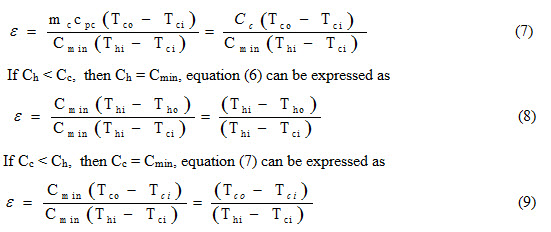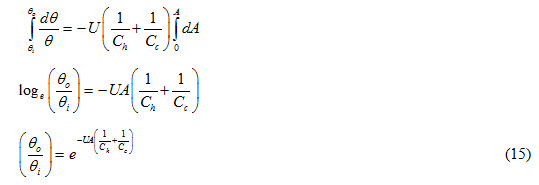Site pages
Current course
Participants
General
Module 1. Basic Concepts, Conductive Heat Transfer...
Module 2. Convection
Module 3. Radiation
Module 4. Heat Exchangers
Module 5. Mass Transfer
Lesson-28 Heat exchanger performance in terms of Capacity ratio, Effectiveness and Number of transfer units, Effectiveness for parallel flow heat exchanger
Effectiveness or Number of Transfer Units (NTU)
Logrithmic mean temperature difference method is very easy and simple to use for performance analysis of heat exchangers when inlet and outlet temperatures of hot and cold fluids are known or can be determined. However, if either temperature of the fluids is unknown or can not be determined, performance analysis by Logrithmic mean temperature difference method becomes cumbersome and complicated due to presence of logarithmic function. In such a case, effectiveness or number of transfer units (NTU) method is used for performance analysis of heat exchangers. Effectiveness or NTU method is based on the following concepts
Capacity Ratio, C
Effectiveness, ε
Number of Transfer Units, NTU
Capacity ratio (C): It is defined as ratio of minimum to maximum capacity rate of fluids being used in a heat exchanger.

as cmin = mh cph and cmax = mc cpc
The fluid with lower heat capacity rate will undergo greater change in temperature as compared to fluid with higher heat capacity rate.
Effectiveness, ε:
Effectiveness of a heat exchanger is defined as ratio of actual heat transferred to maximum possible heat that can be transferred.

Qactual = Heat lost by hot fluid = Heat gained by cold fluid
Qactual = mh cph (Thi - Tho) = mc cpc (Tco – Tci) (4)
Maximum possible heat transfer will be achieved if a fluid undergoes a change in temperature equal to maximum temperature difference available between hot and cold fluid.
Maximum Temperature difference that exists in a heat exchanger = Thi - Tci
Maximum possible heat transfer occurs when a fluid of smaller heat capacity rate undergoes a change in temperature equal to maximum available temperature difference.
Qmaxpossibe = Cmin (Thi – Tci) (5)
Substituting values of Qactual and Qmax possible from equations (4) and (5) in equation (3), we get

Effectiveness may also be defined as ratio of change in temperature of fluid with smaller capacity rate to maximum temperature difference existing in a heat exchanger.
Number of Transfer Units, NTU:
Number of transfer units is a dimensionless quantity and is an indicator of size of heat transferring areas of heat exchanger. Large value of NTU means larger heat transferring area. It is expressed as

(a) Effectiveness for the Parallel Flow Heat Exchangers:
From definition of effectiveness of a heat exchanger, we can write

Heat transferred in a heat exchanger can be expressed as
Q = Ch(Thi- Tho) = Cc(Tco-Tci)
Consider an element of area dA and thickness dx at a distance ‘x’ from inlet of a parallel flow heat exchanger. Let dTh and dTc represent change in temperature of hot and cold fluids respectively during the flow through the element. Temperature difference between hot and cold fluid at inlet of element is expressed as
dθ = dTh - dTc (12)
If dQ is the amount of heat transferred during flow of fluids through the element then
dQ = UdA θ = Cc dTc = - Ch dTh (13)
Substituting the values of dTh and dTc from equation (13) into the equation (12), we get

Integrating equation (14) between limits θi and θo , we get

For a parallel heat exchanger,
θi = Thi –Tci and θo = Tho –Tco
Equation (15) can be written as

Using equation (4), values of Tho and Tco can be written as

Subtracting equation (18) from equation (17), we get

Using equation (19), equation (16) can be written as

If Cc < Ch, then Cc = Cmin and Ch = Cmax equation (20) can be expressed as

If Ch < Cc, then Ch = Cmin and Cc = Cmax equation (20) can be expressed as

Using equations (2) and (10), equation (22) can be expressed as

The following two important cases are considered
i) Gas Turbine:

For a parallel flow heat exchanger, maximum value of effectiveness that can be achieved is 50% irrespective of values of its heat transferring area and overall heat transfer coefficient.
ii) Boiler and Condenser:

